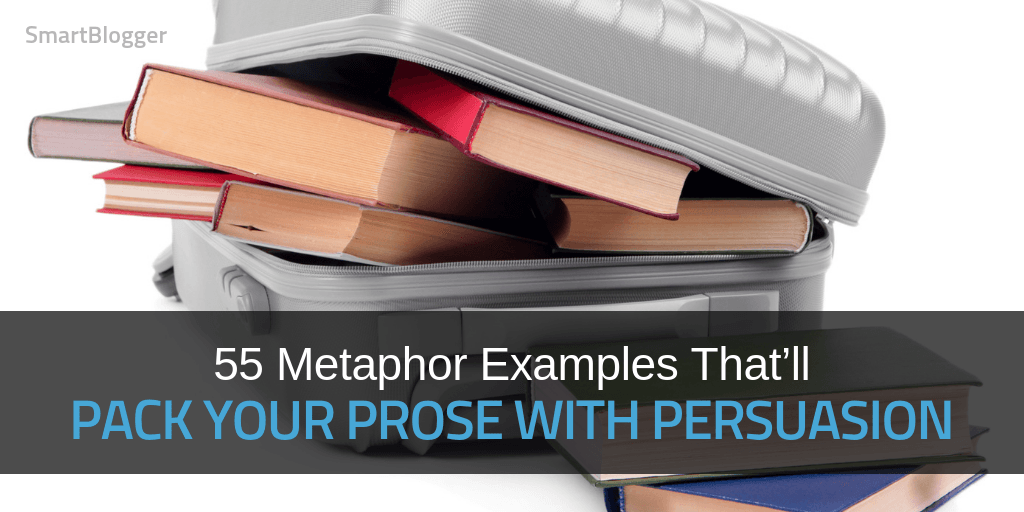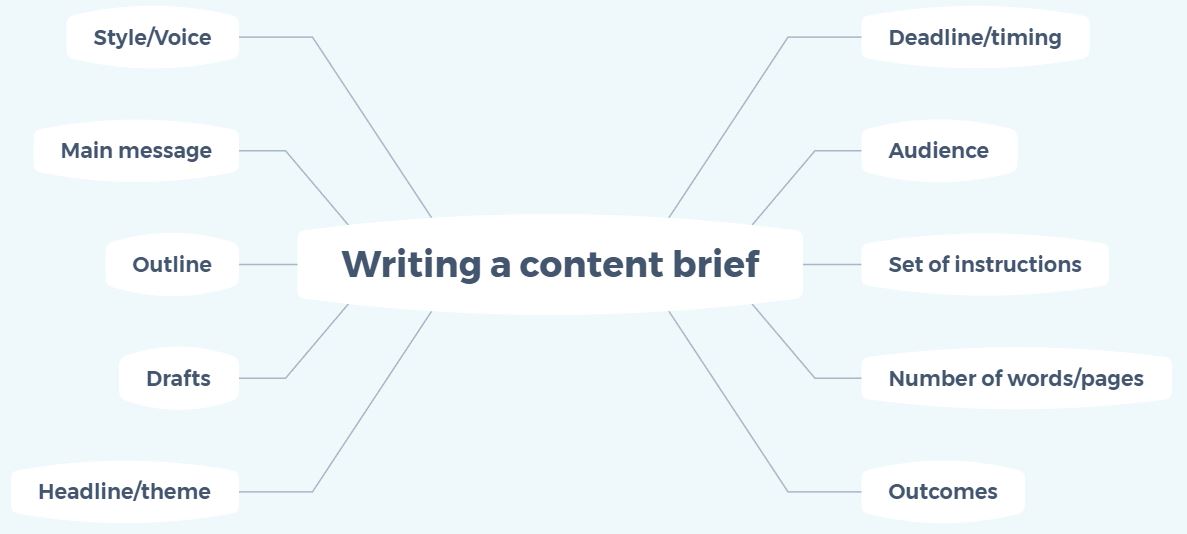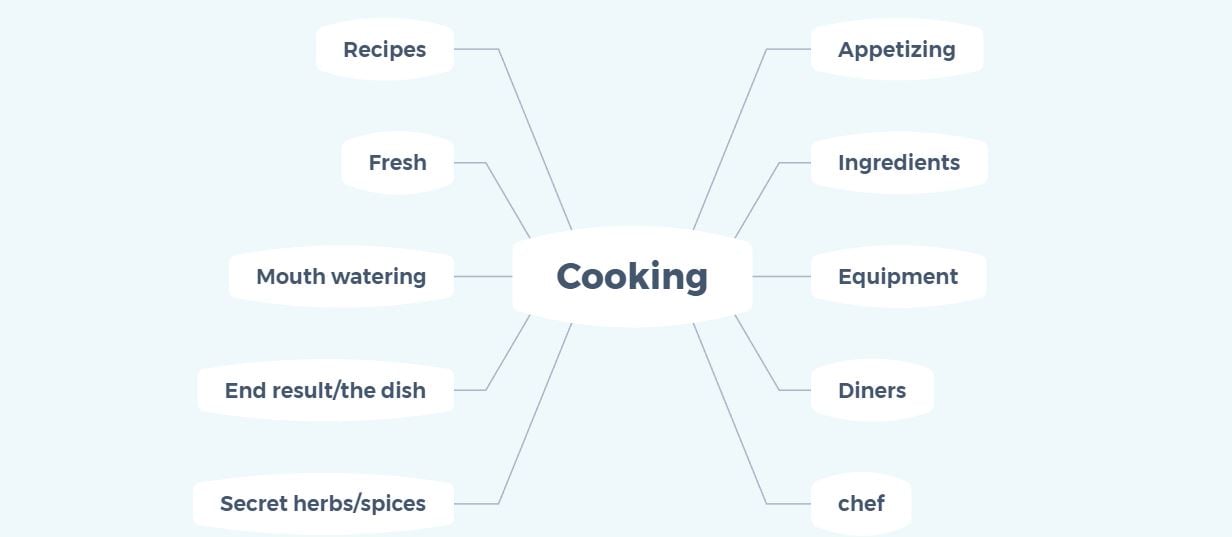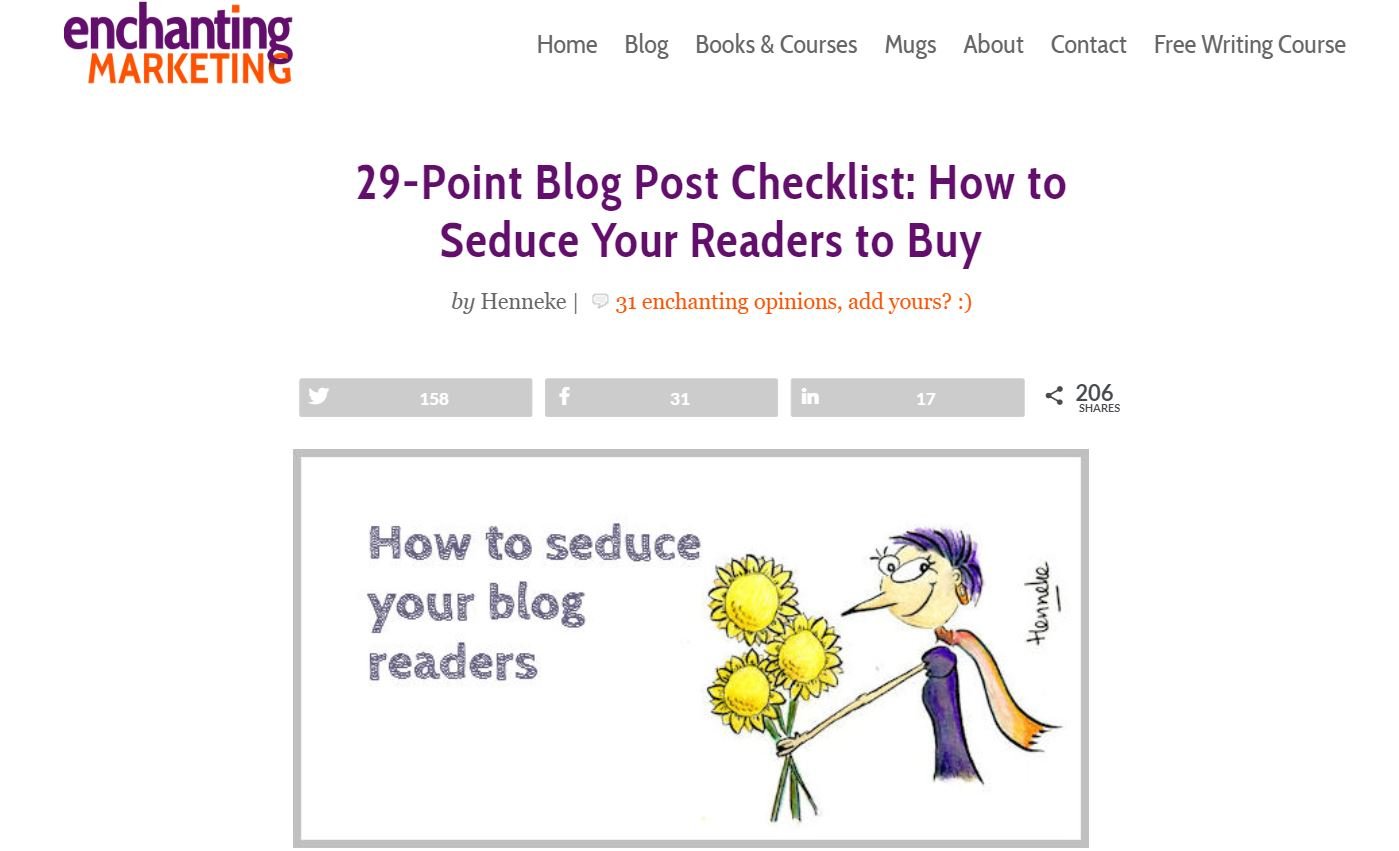Aristotle once wrote, “to be a master of metaphor is a sign of genius.”
And the best way to master the metaphor? Devour lots of good metaphor examples!
So, we’ve compiled a giant list of metaphors from content marketing, literature, famous speeches, and pop culture to give you a go-to resource. You’ll also learn:
- How metaphors and figurative language are related;
- The differences between metaphors and similes, analogies, and hyperbole;
- What are the six common types of metaphors;
- Tips for effectively using metaphors in your own writing.
In short, by the time you finish this post, you’ll be a certified metaphor genius.
But before we get to all that, let’s answer the questions people ask most often about metaphors.

What is a Metaphor?
A metaphor takes an object or action and compares it to something blindingly familiar, but completed unrelated.
The comparison in a metaphor is always non-literal, which makes it weirdly illogical. And yet, its meaning is (usually) abundantly clear.
For example:
“Love is a fruit in season at all times and in reach of every hand.” — Mother Teresa
Love is not a fruit; however, the meaning of the comparison is easily understood.
Here’s another example:
“She was the black sheep of the family.”
Illogical, right? But you get the meaning right away.
Okay, so that’s a metaphor…
What is Figurative Language?
Figurative language is a technique that supercharges your reader’s imagination by taking a flat (or factual) statement and injecting it with life, color, or humor to make it more interesting.
It allows you to paint vivid pictures, punch home your meaning, and be more persuasive as a writer.
A metaphor is one of several figure-of-speech devices that uses figurative language.
Here’s an example:
“The first rays of sunshine gently stroked my face.”
We all know sunshine can’t literally stroke your face, but we can all relate to the sensation. The figurative language makes it more vibrant than something like, “the first rays of sunshine woke me up.”
This type of figurative language is known as “personification,” which uses human qualities (stroking) to better illustrate a non-human action or thing (the sunshine). It’s a technique often found in metaphors.
There are several other figures of speech that use figurative language, including similes, analogies, and hyperbole — which are often confused with metaphors.
So, let’s clear that up for you…
What’s the Difference Between Metaphors and Similes, Analogies, or Hyperbole?
Similes
Simile Definition: A simile is the metaphor’s first cousin. Where a metaphor states that something is something else, a simile compares two different things by using “like” or “as.”
Example of Simile: “Elderly American ladies leaning on their canes listed toward me like towers of Pisa.” — from ‘Lolita’ by Vladimir Nabokov
Difference Between Similes and Metaphors: A simile directly compares two things using “like” or “as” (“he was mad as hell”), while a metaphor implicitly states a comparison, without intending it to be taken literally (“he was boiling mad”).
To the latter example: Obviously, he wasn’t boiling, or he’d be dead. But were he a kettle, his lid would be rattling and steam would be coming from his ears. That’s how mad he’d be!
Analogies
Analogy Definition: An analogy is a turbo-powered simile. While a simile compares two different things, an analogy explains the similarities or relationships between two different things.
Example of Analogy: “Longbottom, if brains were gold, you’d be poorer than Weasley, and that’s saying something.” — from ‘Harry Potter and The Sorcerer’s Stone’ by J.K. Rowling
Difference Between Analogies and Metaphors: While a metaphor uses words or phrases to represent an idea, an analogy uses narrative or comparisons to explain the idea.
Hyperbole
Hyperbole Definition: Hyperbole is an exaggeration that is not intended to be taken literally. It’s most commonly used for emphasis, humor, or drama.
Example of Hyperbole: “I was helpless. I did not know what in the world to do. I was quaking from head to foot, and could have hung my hat on my eyes, they stuck out so far.” — from “Old Times on the Mississippi” by Mark Twain
Difference Between Hyperbole and Metaphors: There is a gray area between the two and it’s often debated. But here are the facts: Hyperbole always uses exaggeration, whereas metaphors sometimes do.
If a metaphor is clearly an exaggeration, it can be described as a hyperbolic metaphor. An example would be, “cry me a river.” Obviously, no one can possibly shed that many tears. On the other hand, “your suitcase weighs a ton” is hyperbole (not a metaphor).
Google “types of metaphors” and you’ll get hundreds of blog posts and scholarly articles with lists of metaphors ranging from 3 to 20+ different types.
Our take?
Focus on the 6 most common types of metaphors:
1. Common Metaphors (aka Direct Metaphors, Primary Metaphors, or Conventional Metaphors)
These are the easiest-to-spot metaphors.
Common metaphors are comparisons where the link can be easily made and directly understood. Example:
“He was a fish out of water at his new school.”
We know immediately what the writer means, even though it’s illogical to compare a school student to a fish.
2. Implied Metaphors
Implied metaphors force you to use your imagination. They don’t make a direct comparison, which is easy to spot. Instead, they imply it.
“She was like a dog with a bone” is a common metaphor. The dog-like comparison is stated.
“She tucked her tail between her legs and rang away,” on the other hand, is an implied metaphor — the comparison to a dog is implied, but not stated outright.
3. Extended Metaphors (aka Sustained Metaphors)
Extended metaphors can be direct or implied, but create a greater emphasis with the comparison they’re making thanks to their extended length. They can continue for several sentences or even paragraphs.
Extended metaphors are often used in poetry and literature where the author wants to convey more passion and commitment to a concept.
Here’s an example from “I Know Why the Cage Bird Sings” by Maya Angelou:
But a BIRD that stalks down his narrow cage
Can seldom see through his bars of rage
His wings are clipped and his feet are tied
The caged bird sings with a fearful trill
And his tune is heard on the distant hill for
The caged bird sings of freedom.
4. Dead Metaphors
Dead metaphors are figures of speech that have been around so long or have been so overused, they have lost their effectiveness.
Phrases like “it’s raining cats and dogs” and “you are the light of my life” have morphed from metaphors into trite banalities and should be avoided.
5. Mixed Metaphors
Mixed metaphors are when two or more inconsistent metaphors get jumbled together — often with humorous consequences.
If it’s used intentionally, a mixed metaphor can be an effective communication technique. But in the wrong hands, a mixed metaphor can become a jumbled mess.
Former British soccer manager, Stuart Pearce, gave us this gem:
“I can see the carrot at the end of the tunnel.”
6. Sensory Metaphors
Sensory metaphors use figurative language to appeal to our senses — sight, sound, smell, taste or touch. As such, they’re immediately familiar and evocative.
Examples:
- “His voice was silky smooth.”
- “Her smile lit up the room.”
Up to this point, you’ve already seen quite a few metaphor examples as we’ve explained the different types of metaphors and gone over several definitions.
Now, let’s get to the meat of the post. Here are 38 examples of metaphors from content marketing, literature, poems, speeches, movies, television shows, songs, and more:
Metaphor Examples from Content Marketing
As a content marketer, you fight a constant battle for attention. You need your words to leap off the page and galvanize your readers into action.
Using metaphors is a great way to do that. Especially if you weave the metaphorical theme through your post. It helps give your writing a more intriguing creative tone. It makes your message sticky and memorable.
Take these examples of metaphors from some of the internet’s best content marketing blogs:
Want to bring your ideas to life, to make them take up residence in the mind of the reader, lurking in the background, tugging, pulling, and cajoling their emotions until they think and feel exactly as you want?
Sonia Simone
Smarter companies think of tone of voice guidelines as bumpers on a bowling lane: They gently guide your communication in the right direction and help content creators avoid a gutter ball.
Doug Kessler
Carefully crafted, purposeful content is ace at just that: generating REAL traffic and leads. It’s no wonder people are climbing aboard the content train. Now that you’re buckled in, the next step is understanding what a professional content writer adds to your marketing strategy.
Henneke Duistermaat
And this is what exasperates me about the ‘blogging and social media for money’ superhighway. So many times I follow the yellow brick road laid by an enterprising blogger who’s working the system. . .and when I get there and pull back the curtain…nothing. No wizard. No magic. And no message. Just a lot of mechanics and whirling buttons and a robotic, soulless special effects machine.
Rusty Weston
All these metaphor examples paint a vivid picture you can see, hear, or even taste. Some of them contain both metaphors and similes, some are extended metaphors, and some are sensory metaphors. But none of them are dead metaphors.
Good metaphors are powerful even when you’re tackling a relatively mundane subject matter, like hiring content writers.
So, imagine how exciting metaphors can be in the hands of great fiction and literary writers whose subject matter can roam anywhere they darn well please.
Let’s look at a few such examples…
Examples of Metaphors in Literature
Metaphors in literature have been around for centuries.
They have cemented glorious stories and ideas into our minds. They have made the words on the page come alive and frolic through our imagination.
Let’s start with the king of literary metaphors:
All the world’s a stage / And all the men and women merely players / They have their exits and their entrances / And one man in his time plays many parts / His act being seven ages.
from ‘As You Like It’
Hands up who doesn’t know these famous lines by William Shakespeare?
You’ll find them in every post and article about metaphors, literary devices, or figurative language, because it’s a classic extended metaphor example that’s hard to beat.
Here’s another one:
But soft! What light through yonder window breaks? / It is the East and Juliet is the sun! / Arise, fair sun, and kill the envious moon / Who is already sick and pale with grief / That thou her maid art far more fair than she.
from ‘Romeo and Juliet’
“Romeo and Juliet” is chock full of love metaphors. Nothing less than the fair sun and envious moon could express the depth of Romeo’s emotional state at that moment. Imagine if he had been factual and said, “What light through yonder window breaks? Oh look, it’s Juliet heading for the bathroom”.
Shakespeare’s magnificent metaphors have wormed their way into our modern language and today we can recite them without a second thought.
Like these examples:
- “A horse, a horse. My kingdom for a horse!” — from Richard III
- “Shall I compare thee to a summer’s day?” — from Sonnet 18
- “Parting is such sweet sorrow…” — from Romeo and Juliet
- “All that glitters is not gold…” — from The Merchant of Venice
- “Why, then, the world’s mine oyster…” — from The Merry Wives of Windsor
I bet you didn’t know that last one was by Shakespeare.
Metaphors are also used throughout the Bible:
I am the good shepherd … and I lay down My life for the sheep.
John 10:14
In fact, the Bible is a hotbed of metaphors, similes, and other types of figurative language:
- “I am the way, the truth and the life.” — John 14:6
- “You are the Father, we are the clay and You our potter; and all of us are the work of Your hand.” — Isaiah 64:8
- “Jesus said to them, ‘I am the bread of life; he who comes to Me will not hunger, and he who believes in Me will never thirst.” — John 6:35
We can find great metaphor examples in recent works of literature too:
Memories are bullets. Some whiz by and only spook you. Others tear you open and leave you in pieces.
from ‘Kill the Dead’ by Richard Kadrey
That’s a formidable metaphor. This one’s a little sweeter:
You’re a marshmallow. Soft and sweet and when you get heated up you go all gooey and delicious.
from ‘One for the Money’ by Janet Evanovich
And this one pulls no punches:
The parents looked upon Matilda in particular as nothing more than a scab. A scab is something you have to put up with until the time comes when you pick it off and flick it away.
from ‘Matilda’ by Roald Dahl
Ouch! Poor Matilda.
Or how about metaphors in poetry? Here’s an extract from a poem written when the author thought she might be pregnant:
This loaf’s big with its yeasty rising / Money’s new-minted in this fat purse / I’m a means, a stage, a cow in calf / I’ve eaten a bag of green apples / Boarded the train there’s no getting off.
from ‘Metaphors’ by Sylvia Plath
Yikes! Can’t you feel Sylvia’s swollen discomfort? Perhaps it was just as well she turned out not to be pregnant after all.
Metaphor Examples from Famous Speeches
Powerful metaphors have been found in great speeches throughout history.
Notable statesmen and leaders know they need to capture the hearts and minds of their audience and nothing does that better than a slam dunk metaphor. Like these:
Hitler knows that he will have to break us in these islands or lose the war. If we can stand up to him, all Europe may be freed, and the life for the world may move forward into broad, sunlit uplands.
Winston Churchill’s ‘Finest Hour’ speech in June 1940
America has tossed its cap over the wall of space.
John F. Kennedy at the Dedication of the Aerospace Medical Health Center in San Antonio, Texas, in 1963
In the dark days and darker nights when England stood alone — and most men save Englishmen despaired of England’s life — he mobilized the English language and sent it into battle.
JFK referring to Winston Churchill
I have a dream that one day even the state of Mississippi, a state sweltering with the heat of injustice, sweltering with the heat of oppression, will be transformed into an oasis of freedom and justice.
Martin Luther King’s ‘I Have a Dream Speech’ in 1963
With this pledge taken, I assume unhesitatingly the leadership of this great army of our people dedicated to a disciplined attack upon our common problems.
Franklin D. Roosevelt’s Inaugural Address in 1933
Examples of Metaphors from Pop Culture
Metaphors don’t always have to be profound or literary. In the hands of song, TV, and movie writers; metaphors are often light, whimsical, and funny (or sad).
But, they’re always entertaining.
Songwriters turn to metaphors because it allows them to be more creative, expressive, and raw with their lyrics. Metaphors in songs are designed to be felt.
Take these lyrics:
You ain’t nothin’ but a hound dog / Quit snoopin’ ’round my door
Elvis Presley
Her heart’s as soft as feathers / Still she weathers stormy skies / And she’s a sparrow when she’s broken / But she’s an eagle when she flies
Dolly Parton
‘Cause, baby, you‘re a firework / Come on, show ’em what you‘re worth / Make them go oh, oh, oh / As you shoot across the sky
Katy Perry
And if you want love / We’ll make it / Swim in a deep sea / Of blankets / Take all your big plans / And break ’em / This is bound to be a while / Your body is a wonderland
John Mayer
In TV and movies, metaphors are often used as a device to handle taboo subjects such as sex or bodily parts. If you dress them up in comedic banter, it makes them more acceptable (and even funny).
The TV show Seinfeld was masterful at this:
Jerry, it’s L.A.! Nobody leaves. She’s a seductress, she’s a siren, she’s a virgin, she’s a who-oooore.
Cosmo Kramer
I need the secure packaging of Jockeys. My boys need a house!
Kramer (on his preference for Jockey shorts)
Just when I think you’re the shallowest man I’ve ever met, you somehow manage to drain a little more out of the pool.
Elaine (to Jerry)
And next time you go to the movies, watch out for an entire metaphorical theme lurking behind the scenes:
Truman is a metaphor for conquering fears, perseverance, and not accepting the reality with which we’re presented. Some also claim there are controlling government and antichrist themes played out through the reality show’s creator, Christof. — The Truman Show
On the surface, it’s about a bickering couple who discover they are spies for rival agencies. But it’s actually a metaphor for the sanctity of marriage, meaningful communication, and learning to be vulnerable. — Mr. and Mrs. Smith
Phil Connors (portrayed by Bill Murray) is stuck in a time warp. He relives the same day over and over until he changes into a better person. The metaphor is one of self-discovery and improvement, which many say are rooted in Buddhist philosophies. — Groundhog Day
Now that we’ve looked at numerous metaphor examples, let’s go over some practical tips that’ll help you use metaphors in your own writing.
1. Use Metaphors in Your Headlines
We all know that headlines are the most important part of your post. If your headline doesn’t grab your reader’s attention, the rest of your post will be dead in the water.
So, what better place to slip in a nifty metaphor than in your headline? Like so:
2. Make an Entire Post or Article Metaphorically Themed
This is a great way to bring a subject to life or make a complex idea more easily understood. Here’s how:
First, take your subject and think of a second concept you could align it to. Let’s say your subject is “how to write a content brief,” which involves a formula and process — a bit like cooking. So, let’s use that as your second concept.
Now start brainstorming words and ideas that can be applied to each concept separately:


Next, look at your two lists and identify words or ideas that might overlap:
- “Set of instructions” and “recipes”
- “Audience” and “diners”
- “Outcomes” and “end result”
- “Style/voice” and “secret herbs and spices”
- “Outline” and “ingredients”
Can you feel a theme coming on?
3. Use Metaphors to Make Facts and Figures Come to Life
Data. Facts and Figures. We all know they’re important to substantiate your arguments, but on their own they can be meaningless and, to be honest, downright boring.
If I told you the circumference of the earth was 24,901 miles, you’d probably yawn.
But if I said the circumference of the earth was 801,500 Olympic size swimming pools laid back to back, it paints a much more relatable picture.
Think about the way we teach children how to add and subtract. We say, “if I give you three apples and take away one, how many are you left with?”
We are no different as adults. Our brains process facts and figures more effectively when they are anchored to a relatable or concrete idea.
4. Be Sure to Use Metaphors Relevant to Your Audience
Think about who you are writing for and the context of your subject matter. If your post is aimed at teenage girls, you probably wouldn’t use a war analogy.
On the other hand, writers in the self-improvement niche often use metaphors related to battles as we strive to conquer our demons and make changes in our lives.
Use metaphors that are relevant to the times we live in and changes in our society and culture. Think about the age and generational context of your audience. If they are young, don’t use outdated or old-fashioned metaphors that will leave them cold.
5. Use Metaphors to Make Dull Ideas Sparkle
Like it or not, there’s probably going to come a time when you find yourself having to write about something dull.
That’s when metaphors become the writer’s best friend.
Metaphors allow you to hold your audience’s attention by shifting their focus away from the boring bits onto something far more imaginative and creative.
Kristina Halvorson does this in her post How to Embrace (and Gently Encourage) the Content Audit.
Let’s face it, a content audit is not the most riveting subject matter, but Kristina manages to bring it to life by comparing audits to clearing up other people’s “icky detritus” after the winter snow has melted.
6. Metaphors Don’t Have to Be Written (Or, Get Creative With Metaphorical Images)
Metaphors don’t have to be limited to text. You can make your point just as powerfully — and faster — with a metaphorical image.
In blogging, no one does metaphorical illustrations better than Henneke Duistermaat and her hand-drawn “Henrietta” cartoons.

We can’t all be talented artists like Henneke, but we can find entertaining or moving images that represent our message.
But…
When you’re searching for the right image on sites like Unsplash and Gratisography, remember not to think literally. Think metaphorically.
Let’s say you want to write a post on writer’s block. The obvious image would be something like this:

Photo by Steve Johnson
But that’s too obvious. What we need is a metaphor for writer’s block.
What emotions would you compare to writer’s block? Emptiness, fearfulness, loneliness, frustration, feeling trapped?
Look for images that capture one or more of those feelings. Like this:

Photo by Aarón Blanco Tejedor
Which of those two images is going to attract more attention and add more spice and character to your blog post?
7. Avoid the Cliches and Don’t Overdo Your Metaphor Quota
Finally, here are a few what not to-dos:
- Don’t overuse metaphors. Go for a simple metaphorical theme or sprinkle a few well-placed metaphors for the sake of clarity or persuasion. Too many will weigh your post down and start to sound messy.
- Don’t force metaphors into your writing. It’s like overusing adjectives or flowery words. Readers will spot them a mile away.
- Avoid the overly obvious or dead metaphors. They tend to be clichéd and have lost their ability to conjure up a visual image. Examples are “going belly up,” “kicking the bucket,” and “you light up my life.”
You Just Read the Definitive List of Metaphor Examples. Ready to Unleash Their Power?
Metaphors are all around us.
They sneak into our everyday language (“the traffic was a nightmare”) and help us form impressions of people and situations (“he fought cancer and won”).
But most of all — as I hope these examples of metaphors have shown you — they are one of the most powerfully-persuasive devices in a writer’s toolbox.
Metaphors are a zap of electricity between you and your audience — a jolt that’s often the difference between a lackluster sentence and a sparkling gem of persuasive genius.
So, next time you want to compel your readers to take action, savor your words, or quickly grasp your meaning, use a metaphor.